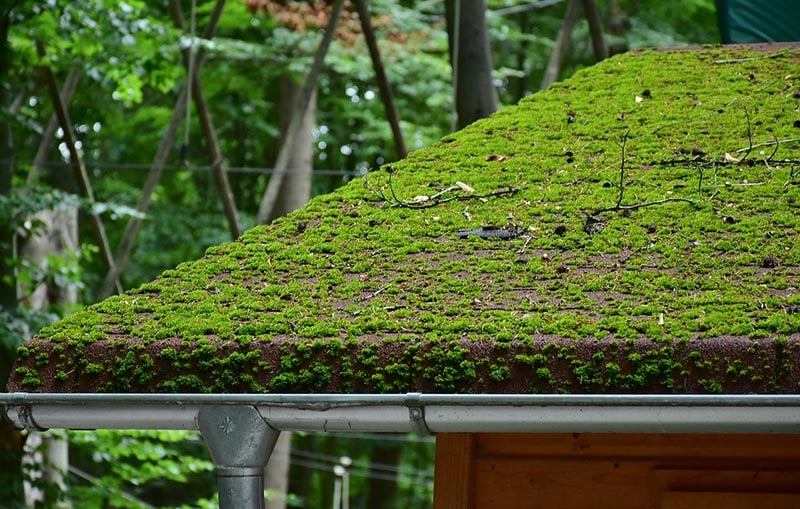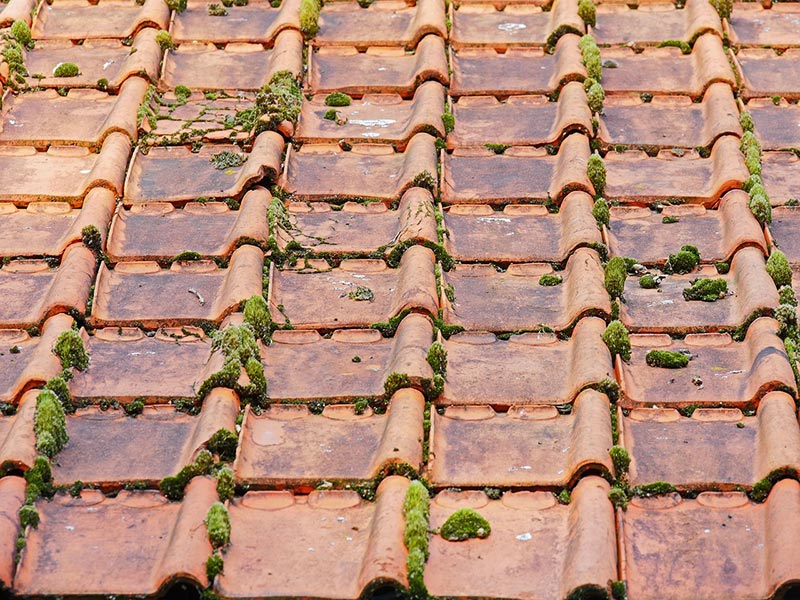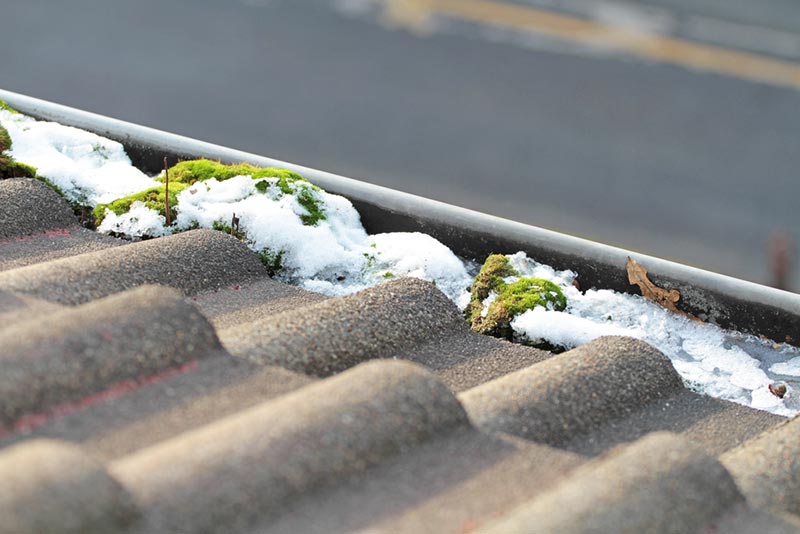When Is the Best Time of Year to Remove Roof Moss? Facts & Tips
-
Jeff Weishaupt
- Last updated:

Have you tried everything to remove moss from your roof but failed every time? It could be possible that you’re not applying the treatment at the right time of the year. The best season to remove roof moss is summer.
Moss is inactive in dry weather, making it the most vulnerable to chemical-based killers. In some cases, you can even remove it manually with a slight wash or a broom.
The ideal time to prevent moss damage is to remove it when it becomes visible. This guide will discuss everything you need to know about the moss problem.
Why Is Moss Removal Essential?
If you have moss on your roof for the first time, you may not take it as seriously as you should. That’s the biggest mistake most homeowners make. Mosses may look like harmless, flowerless plants that thrive in dense mats, but they are more than that.
Moss in your home, especially on the roof, is dangerous for the integrity of the structure. When it covers your entire roof, it can damage your home’s ceilings and walls.
Here are some other reasons why moss removal is so necessary:
- Excess Moisture: Continuous moisture on the roof can lead to erosion on its top surface. Not only that, but it can also result in rotting, leaking, and rusting of the roof. Unfortunately, moss absorbs and retains moisture in the roof.
- Gradual But Harmful Growth: Moss grows slowly but insidiously. This means you’re more likely to identify the growth of moss on your roof when it covers half of your roof. Unfortunately, this enables moss to reach your roof’s shingles and tiles and push them up. As a result, the entire structure of your roof weakens.
- Impact on Your Property’s Aesthetics: Moss also makes your house look less attractive to potential buyers. Even if you have enhanced your lawn or front porch, a layer of moss on the roof will undo it.
- More Weight on the Roof: The roof is an essential but delicate part of your home supported by walls. Thus, it’s better not to put much weight on the roof. However, moss can add additional weight to it.
- Pest Attraction: Moss is believed to attract many pests, including fireflies, mosquitoes, fleas, and ticks. So, when they grow on your roof, they can bring all of these pests to your home daily.

The Right Time to Remove Moss From the Roof
Summer is the ideal time to remove moss as the dry weather makes it susceptible to moss killers. It mostly starts in May and continues till October. However, summer arrives at different times in some states. You should determine the appropriate months for roof treatment accordingly.
Contrastingly, the moss becomes mature in fall, water, and spring. At this time, it is prepared to reproduce and grow to your entire roof.
Before applying the killer, you should wait for the temperature to stay above 15ºC (59ºF) for 2–3 days. That’s because the chemicals usually act slower on cold days than on hotter ones. So, the moss may not seem instantly affected after the chemical application.
Consult a Roofing expert
Find a roofing specialist in your area, and get free, no-commitment estimates for your project.

Why Is It Important to Apply Moss Killers in Summer?
The hot weather doesn’t support plant germination and spore production. Also, most moss killers consist of fatty acids-based ammoniated soap that needs significant time and water to activate and get absorbed. That’s why the moss rhizoids absorb chemicals better during rainy seasons.
If you forget to clear moss in summer, you can do it in spring. It is the second-best time to apply moss killers since it is the rainy season. The water stays wet for a long time, accelerating the absorption of chemicals.
However, if it’s not the rainy season, you’d need to ensure the presence of water on your roof, or else the moss won’t absorb the chemical solution and will continue to grow.
Spraying moss killers at the right time will also disrupt its survival in the winter. Here is a quick breakdown of moss removal at different times of the year:
Spring Season
As you know, spring is considered the second-best season for moss removal since it rains a lot at this time. Molds and moss love to thrive in warm, damp conditions, so they are likely to reproduce and grow in spring.
Therefore, the right time to apply the moss removal is before the arrival of spring. Doing so will inhibit its growth and cut its lifecycle short in the entire season.

Fall Season
To ensure your roof is clear of moss, you must also apply a follow-up moss removal treatment on your roof in the fall. The right time to do it is in the middle of the season. During this time, the sun is still visible, so the roof will dry up faster, and the moss will be less active.
Fall follow-up treatment will also help you remove the moss that started to grow in the summer. In case you forget to do this follow-up treatment, wait for spring to do it. Never try to remove moss in winter, as it’s never an ideal time to go to the roof.
Winter Season
There are many reasons winter is considered the worst time for moss removal. First, it’s very dangerous to get on the roof during this time because of the freezing weather and snow. Yes, you may wear safety gear when reaching the roof, but you can’t wholly be safe from falls and slips.
Second, moss can’t survive on colder days. The freezing weather kills moss on its own, so you don’t have to do anything to remove it. If you see a few traces of mold on your roof, it could be the remaining moss colonies. New moss can’t bear freezing weather conditions.
Third, many moss removal techniques are ineffective during winter. The layers of snow make it impossible for you to reach the moss. So, whether you try to cut the moss layer or wash the roof with detergent, your efforts will likely go in vain.
But if you still want to remove moss in winter, you should let the professional do the job. The expert would know all the precautionary measures and effective moss removal techniques.

The Ideal Conditions to Apply Moss Killers
We now know that both season and weather play a major role in the effectiveness of moss killers. While you keep both factors in mind when applying the chemicals, don’t forget to consider the ideal conditions. They are:
- Temperature Higher Than 32°F: Extreme temperatures are never ideal for moss application. Although moss killers work better on hot days, strong sunshine can significantly reduce their effectiveness.
- No Rain Is Forecasted for the Next 4–5 Hours: Too much water on the roof can dilute the moss killer and make it less effective when the plant absorbs it.
- Cooler Day: Make sure the day is not too windy or the chemical will evaporate from your roof quickly. Comparatively, a calmer and cooler day supports the moss application.
The 4 Easy Ways to Remove Roof Moss
You can remove roof moss in many ways. While using a moss killer is the easiest method, you can also opt for other environmentally friendly options. Luckily, they are easy too. Here are four common ways to remove roof moss:
1. Cut the Moss Layers
If your roof has few or small layers of moss, you can easily cut them off. This should be your first-hand treatment for moss. After cutting the moss, use a brush to gather the residual debris and dirt and dispose of it.
2. Use DIY Moss Killers
If you are allergic to chemical-based moss killers, you can make a natural one at home. Simply go to your pantry and collect some ingredients, including bleach, baking soda, vinegar, soap, dish-washing soap, and detergents.
Mix any of these ingredients with water to prepare a homemade moss removal DIY solution. For example, mix 1 cup of bleach with 1 gallon of water. Then, spray it all over your roof for 20 minutes. Finally, rinse it off with water.
3. Spray Water
After cutting the moss or using any natural treatment, rinse it off with water from a pressure hose. You’d need to screw a jet attachment at one end of the hose. Then, get to the roof and spray the material at low pressure. Avoid watering the roof’s shingles, as it may damage them.
4. Inhibit Moss Growth With Zinc or Copper
Moss despises zinc and copper. Install zinc or copper strips on your roof. When it rains, the water and the strip react and prevent moss from developing on the roof.
In Conclusion
Moss growth is never a pleasant sight. They not only damage your house’s aesthetics but also affect the integrity of your roofing structure. This is why getting rid of them is very important.
The best time to remove roof moss is summer, followed by spring and fall. If you forget to remove moss in all these seasons, don’t try to do it in winter. Simply wait for spring to return to apply the moss treatment!
Featured Image Credit: gotphotos, Shutterstock
Contents
